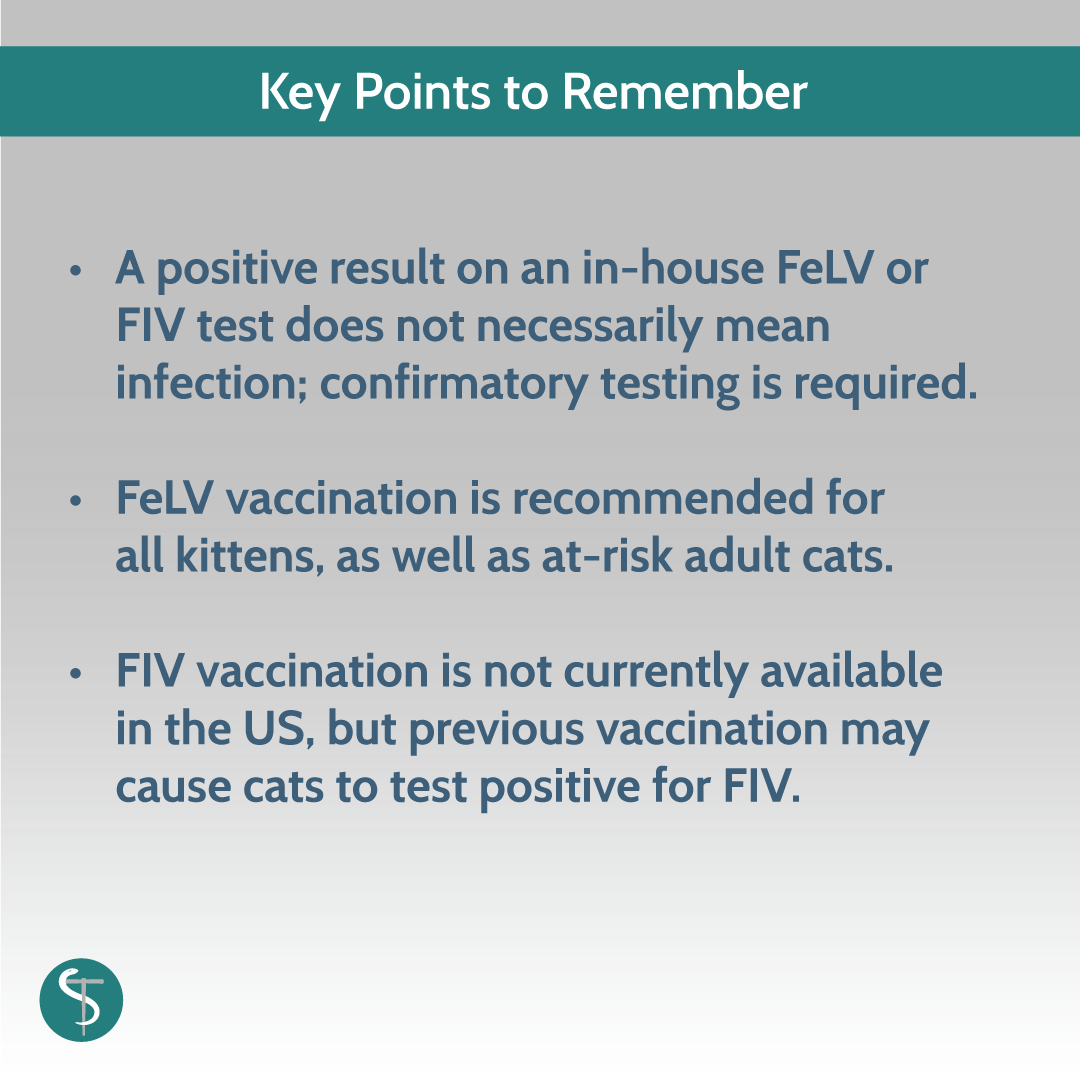
Feline leukemia virus (FeLV) and feline immunodeficiency virus (FIV) are chronic retroviral infections with significant impacts on feline health. Studies suggest that each of these conditions has a prevalence of approximately 2-4% of North American cats.1-2

Diagnosis of Retroviral Infections
The diagnosis of FeLV or FIV typically begins with an in-house test. These tests look for the presence of FeLV antigen and FIV antibodies.
Testing for FeLV/FIV should be performed any time that a cat:
- Is brought into a new home
- Is about to receive its first FeLV/FIV vaccine
- Has been exposed to a cat that may have FeLV or FIV
- Is acting clinically ill3
While in-house FeLV/FIV tests are convenient and provide rapid results, they are not definitive. False positives may occur, especially in healthy, indoor cats with limited exposure risks. Positive in-house results should always be verified with confirmatory testing. There are a number of different confirmatory tests, each with different applications. If a positive in-house result is obtained, the veterinarian will determine the most appropriate confirmatory test.
It is also important to note that FIV vaccination will result in positive results on in-house FIV testing. While most clients know whether their pet has received an FIV vaccine, newly-obtained pets may have an unknown history. If a positive result is obtained on a cat that may have had previous vaccines, additional testing is necessary.
Fortunately, false negatives on FeLV/FIV tests are rare, as long as sufficient time has elapsed since exposure. A positive result on a FeLV test should be seen within 30 days of exposure, while a positive result on a FIV test may take as long as 60 days after exposure to develop.3
Preventing FeLV Infection
Feline leukemia is typically regarded as a disease of “friendly cats.” It is primarily spread through close contact, mutual grooming, and sharing of food and water bowls. Additionally, kittens may be infected by their queens. Cats are most susceptible when they are young, although adult cats are not entirely immune to this condition.
Cats at risk of FeLV should be vaccinated for the condition. At-risk cats may include outdoor cats, cats living in homes with high turnover (an owner who fosters other cats), and cats living with an FeLV-positive housemate. There are a number of available vaccines, all of which are effective at preventing progressive disease.
Guidelines released by the American Association of Feline Practitioners (AAFP) recommend vaccinating all kittens for FeLV.3 Kittens are most susceptible to FeLV infection and they are also the most likely to experience progressive disease and death. Additionally, many owners do not truly know whether their cat will remain indoors-only until the cat reaches adulthood, so it is challenging to perform an accurate risk assessment on a kitten.
Kittens receive an initial series of two vaccinations, with the first dose administered at or after 8 weeks of age and the second vaccine given approximately 3 weeks later. One year later, the cat should receive a booster vaccine. Whether to continue vaccination beyond this point depends on the cat’s lifestyle. Vaccination may be discontinued if the cat is not at risk, repeated annually in cats at high risk, or repeated every two years if the cat’s lifestyle is low-risk.3-4
Preventing FIV Infection
Feline immunodeficiency virus is typically regarded as a disease of “unfriendly cats.” It is spread primarily through bite wounds. Vertical transmission (from queen to kittens) is rare.
There is currently no commercially available FIV vaccine in the United States. However, a vaccine did previously exist and that vaccine is still available in some countries. Therefore, you may still encounter vaccinated cats, as well as clients with questions about FIV vaccination.
There are a number of challenges that accompany FIV vaccination. First, the vaccine’s efficacy is only approximately 50%.5 Second, vaccination results in cats testing positive for FIV for unpredictable amounts of time. While both of these challenges are clearly significant, the fact that they exist in combination makes it very difficult to detect the vaccine failures that we fully expect to occasionally see.
Given the lack of an available vaccine, the best way to prevent FIV is to limit intercat aggression. Cats should be kept indoors if at all possible. Outdoor cats should be neutered, to reduce the likelihood of territorial aggression. Finally, it is important to test new additions to any home that already owns cats.
Key Points to Remember

- A positive result on an in-house FeLV or FIV test does not necessarily mean infection; confirmatory testing is required.
- FeLV vaccination is recommended for all kittens, as well as at-risk adult cats.
- FIV vaccination is not currently available in the US, but previous vaccination may cause cats to test positive for FIV.
References
- Levy J K, Scott HM, Lachtara JL, et al. Seroprevalence of feline leukemia virus and feline immunodeficiency virus infection among cats in North America and risk factors for seropositivity. J Am Vet Med Assoc 2006; 228: 371–376.
- Burling AN, Levy JK, Scott HM, et al. Seroprevalences of feline leukemia virus and feline immunodeficiency virus infection in cats in the United States and Canada and risk factors for seropositivity. J Am Vet Med Assoc 2017; 251: 187–194.
- Little S, Levy J, Hartmann K, et al. 2020 AAFP Feline Retrovirus Testing and Management Guidelines. Journal of Feline Medicine and Surgery 2020; 22: 5-30. Retrieved from: https://journals.sagepub.com/doi/pdf/10.1177/1098612X19895940
- Jirjis F, davis T, Lane J, et al. Protection against feline leukemia virus challenge for at least 2 years after vaccination with an inactivated feline leukemia virus vaccine. Vet Ther 2010; 11: E1–E6.
Westman ME, Malik R, Hall E, et al. The protective rate of the feline immunodeficiency virus vaccine: an Australian field study. Vaccine 2016; 34: 4752–4758.




